Page Sections:
General Safety | Know The Code | Powder Safety | Avalanche Safety | Smart Style | Dog Policy | | Drone Policy |
Uphill Access |
Hey Bud | AirFlare App
This is your guide to safety when you ski or snowboard at Sierra-at-Tahoe. We prepare the mountain each day for you and this guide is designed to help you - our valued guests - ski or snowboard safely and responsibly while having a fun experience with your family and friends.
Due to the damage sustained from the Caldor Fire, the landscape of Sierra has changed, and additional precautions should be followed:
WARNING: FOR YOUR SAFETY
- Read and follow Your Responsibility Code.
- Stay out of Closed Areas. Skiing or riding in a Closed Area is a violation of Penal Code sections 602 (k) and (r).
- Gladed Areas are closed due to danger posed by fire damaged trees.
- Off Piste and Gladed Areas contain unmarked obstacles and are not patrolled.
- The trail map is conceptual and is a general depiction of the terrain. The trail and lift designations on this map supersede any prior maps or brochures.
- This is a partial list. Be aware of your surroundings and use common sense
- Actual conditions may vary
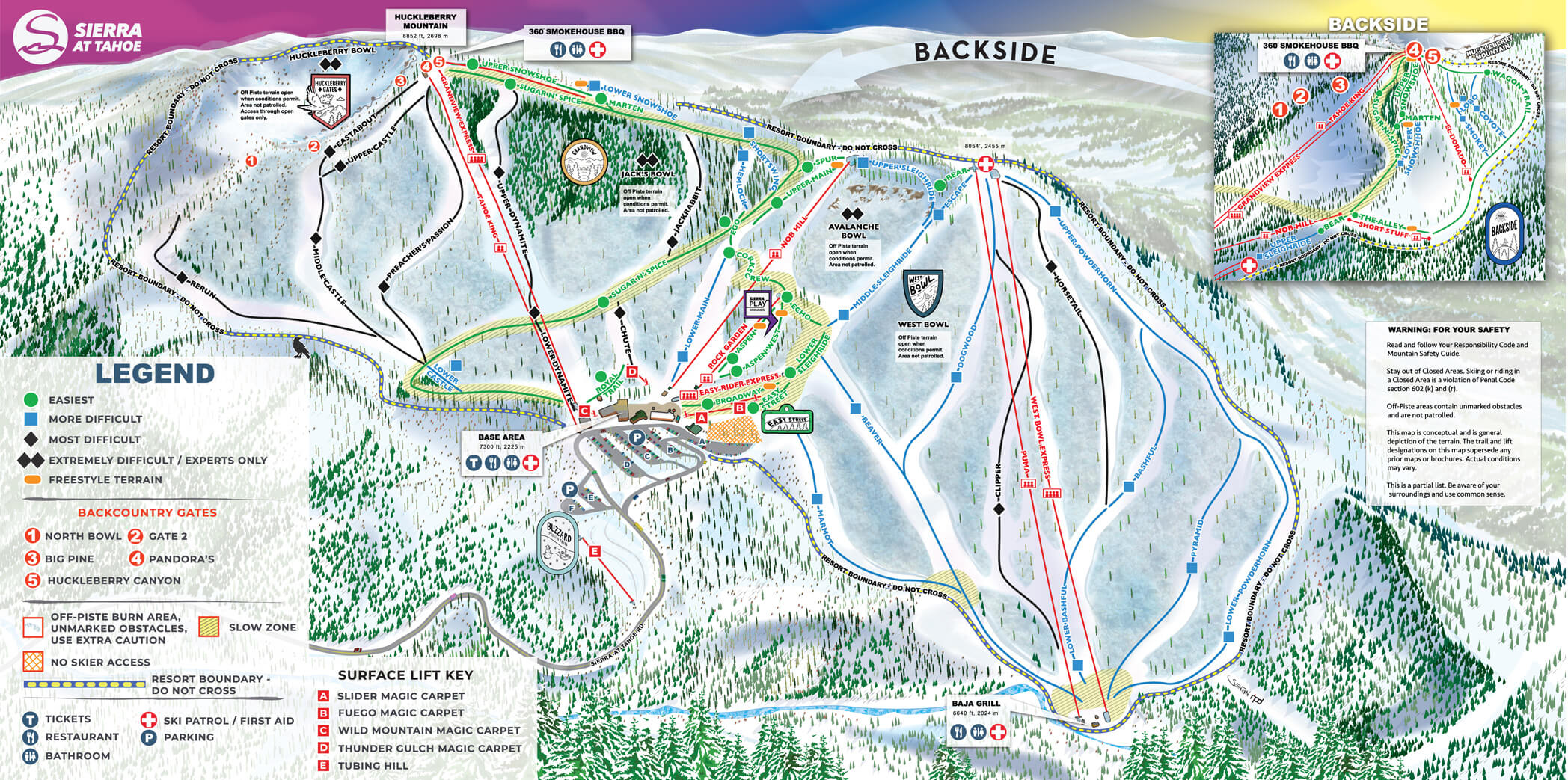
We are committed to addressing safety every day and in every facet of our operations. This includes, but is not limited to:
- Providing education on how to ski and snowboard responsibly, including lessons from qualified instructors.
- Training ski patrol to provide first aid, assess mountain safety, post warnings and conduct avalanche mitigation (when necessary).
- Conducting ongoing lift inspections and maintenance, working with regulatory agencies and training staff to safely operate lifts.
- Monitoring weather and mountain conditions and modifying operations when appropriate.
- Providing trail difficulty rating symbols specific to Sierra's terrain and using industry-approved signage to direct and educate guests.
This guide is part of our commitment. Learning and practicing what is contained in this guide, using common sense, and making good decisions will contribute to your safety and the safety of all guests. Please be responsible, aware and courteous at all times to ensure the safety of all guests.
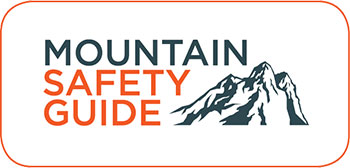
Click on the buttons below to view California Ski Industry Association (CSIA) Safety Guide + watch media coverage of the launch of the program:
Sierra-at-Tahoe X AirFlare
About AirFlare
AirFlare transforms a mobile phone into a safety and rescue personal locator device, that enables Sierra Ski Patrol to quickly locate a skier in need of assistance, whether in or out of cell service. AirFlare also provides a number of self-help features. Like the ability to determine the exact location of a friend or family member with a single push of a button, then quickly navigate to them. Sierra Ski Patrol has adopted AirFlare Search Technology as part of an ongoing effort to promote mountain safety.
General Safety
Like A Rolling Snowball...
We are committed to the environment and safety in everything we do. From day-to-day operations to long-term planning, we're always keeping your safety and our environment's best interests in mind. Maybe that's why we've won numerous awards for outstanding dedication to safety and the environment. Remember, respect gets respect. Here are some great tips to ensure you have the very best and safest time possible while up here.
Sierra has added several areas to the mountain called slow zones which visibly designate an entire run or area as a “go slow area”. These zones are signed with 15 mph speed limits and are patrolled by Ski Patrol and Mountain Safety.
One of the slow zones is Sugar N’ Spice, a 2.5 mile beginner run that starts at the very top of the mountain, allowing beginner skiers and riders to access the mountain via Grandview Express and take in the spectacular views from the top. Other slow zones include the beginner runs of Ego, Corkscrew, Echo and Lower Sleighride. Together, the slow zones provide an easy way down on speed-controlled runs offering beginner skiers and riders or families with young children a non-intimidating route down the slopes.
Remember, you can't have love without a little R-E-S-P-E-C-T.
Before you Ski or Ride
- Use properly maintained equipment. Have bindings inspected and correctly adjusted by a certified technician.
- Dress in water- and wind-resistant outerwear and layers to accommodate changing conditions.
- Use sunscreen and wear goggles or sunglasses. The sun at altitude is intense, even on cloudy days.
- Skiing and snowboarding are active sports. Know your physical limits.
- Take a lesson. Every experience level can benefit from professional instruction.
On the Slopes
- Ski or Ride in Control. Be aware of your surroundings at all times. Ski or ride at a speed you are able to safely stop and avoid others and objects you may encounter.
- Look Out for Hazards and Obstacles (natural and man-made). Sierra uses poles, flags, discs, ropes, fencing, signs and other devices to provide visual warnings. We can not mark all hazards and obstacles. Be aware of changing conditions.
- Do NOT go under ropes or enter closed areas. Ropes and closures are in place for your safety.
- Do NOT Ski or Ride Impaired. It is unsafe and against the law. Be responsible with alcohol and consumption.
- Stay Hydrated. Your body requires more fluids at higher elevations.
- Know Your Limits. If you're tired, STOP. If you're injured, contact Ski Patrol.
- NO Horseplay. Always be respectful of others.
- Look Out for Over-Snow Vehicles. They may be on the slopes heading uphill or downhill, so stay clear of them at all times.
Heads Up – Know the Code, It’s Your Responsibility
Skiing can be enjoyed in many ways. At ski areas you may see people using alpine, snowboard, telemark, cross country and other specialized ski equipment, such as that used by disabled or other skiers. Regardless of how you decide to enjoy the slopes, always show courtesy to others and be aware that there are elements of risk in skiing and snowboarding that common sense and personal awareness can help reduce. Know your ability level and stay within it. Observe Your Responsibility Code listed below and share with others on the slopes the responsibility for a great snowsports experience.
Your Responsibility Code
- Always stay in control. You must be able to stop or avoid people or objects.
- People ahead or downhill of you have the right-of-way. You must avoid them.
- Stop only where you are visible from above and do not restrict traffic.
- Look uphill and avoid others before starting downhill or entering a trail.
- You must prevent runaway equipment.
- Read and obey all signs, warnings and hazard markings.
- Keep off closed trails and out of closed areas.
- You must know how and be able to load, ride and unload lifts safely. If you need assistance, ask the lift attendant.
- Do not use lifts or terrain when impaired by alcohol or drugs.
- If you are involved in a collision or incident, share your contact information with eachother and a ski area employee.
Freestyle Terrain Areas
Freestyle Terrain Areas are designated with an orange oval and may contain jumps, hits, ramps, banks, fun boxes, jibs, rails, half pipes, quarter pipes, snowcross, bump terrain, and other constructed or natural terrain features. Prior to using Freestyle Terrain, you are responsible for familiarizing yourself with Freestyle Terrain and obeying all instructions, warnings, and signs. Freestyle skills require maintaining control on the ground, and in the air. Use of Freestyle Terrain exposes you to the risk of serious injury or death. Inverted aerials are not recommended. You assume the risk.

Freestyle Terrain has designations for size - Small features, Medium features, and Large features. Start small and work your way up. Designations are relative to this ski area.
- MAKE A PLAN. Every time you use freestyle terrain, make a plan for each feature you want to use. Your speed, approach, and take off will directly affect your maneuver and landing.
- LOOK BEFORE YOU LEAP. You are responsible for inspecting Freestyle Terrain before initial use and throughout the day. The features vary in size and change constantly due to snow conditions, weather, usage, grooming, and time of day. Do not jump blindly. Use a spotter when necessary.
- EASY STYLE IT. Always ride or ski in control and within your ability level. Do not attempt Freestyle Terrain unless you have sufficient ability and experience to do so safely. You control the degree of difficulty you will encounter in using Freestyle Terrain, both on the ground and in the air.
- RESPECT GETS RESPECT. Respect Freestyle Terrain and others. Only one person on a feature at a time. Wait your turn and call your start. Always clear the landing area quickly. Respect all signs and do not enter Freestyle Terrain or use features when closed.
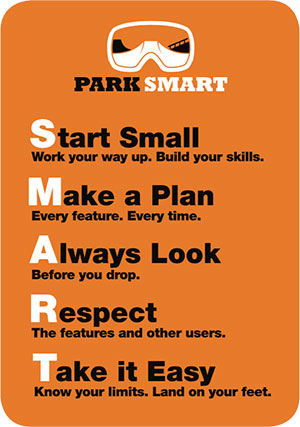
3) Lift Safety
Be advised that you cannot board a lift unless you have sufficient physical dexterity, ability, and knowledge to negotiate or to use such lift safely, or until you have asked for and received information sufficient to enable you to load, ride, and unload the lift safely. You may not use a lift or any ski trail when under the influence of drugs or alcohol.
LOADING:
- Remove pole straps from wrists and hold in one hand. Remove back-packs and hold in your lap. Remove back foot from snowboard binding.
- Be lined up with other guests and prepared to load before moving forward from the “Wait Here” area.
- After the chair in front passes, move from the “Wait Here” area to the “Load Here” area.
- At the “Load Here” area, look back and grab the part of the chair that is easiest for you, typically a side bar or backrest.
RIDING:
- When a restraint bar is available, tell others and lower the bar when you can do so safely.
- SIT BACK and remain seated.
- NO HORSEPLAY.
- Do not turn around, or otherwise move on the chair, even if the lift slows or stops. Never jump from the chair
UNLOADING:
- Check for loose clothing or equipment (such as backpacks) to make sure it will not get caught.
- If a restraint bar is lowered, tell others and then raise the bar before the “Unload Here” area.
- Keep your ski tips or the front of your board up and straight ahead.
- After unloading, move away from the unload ramp.
- If you fail to unload at the “Unload Here” area, remain completely seated and wait for further assistance. DO NOT JUMP.
4) Caution – Machinery Operating at all Times
Be cautious of snowcats, snowmobiles, and snowmaking that may be encountered at any time.
5) Slow Zones
Certain areas (highlighted on the map) are designated as SLOW ZONES. Please observe the posted slow zone areas by maintaining a speed no faster than the general flow of traffic. Fast and aggressive skiing and riding will not be tolerated.
6) Helmet Use
Helmets are a smart idea. Sierra encourages you to educate yourself on the benefits and limitations of helmets. If you choose to wear one, please ski or ride as if you are not wearing one. Every winter sport participant shares responsibility for his or her safety and for that of others using the ski area facilities.
7) Backcountry Warning
The ski area assumes no responsibility for skiers or riders going beyond the ski area boundary. Areas beyond the ski area boundary are not patrolled or maintained. Avalanches, unmarked obstacles, and other natural hazards exist. Rescue in the backcountry, if available, will be costly and may take time.
8) Animals at the Mountain
Dogs are a man's best friend. And we agree. But bringing your dog or other pets to Sierra is not encouraged. Not all of our guests like animals, and we like to respect all guests. So please keep your pet home if possible. No one, even your furry friend, likes sitting in a car all day. Trust us, your dog will thank you for it in the end. If you must bring your pet to the mountain, please be aware that they must be on a leash and controlled at all times, and they are prohibited from coming into the base area or on the mountain. We appreciate your cooperation.
9) Trail Signage
Sierra trail maps contain a wealth of information, including trail and lift locations, trail difficulty rating symbols, and where to find information, ski patrol, and other mountain services.
Trail difficulty ratings are relative to Sierra's specific terrain. A blue square trail at Sierra may be easier or more difficult than a blue square trail at another resort. Work your way up from easier to more difficult trails. When in doubt about a trail or what type of terrain a particular lift serves, ask our staff for guidance.
Trail rating symbols indicate the difficulty level of terrain. Here’s what they mean:
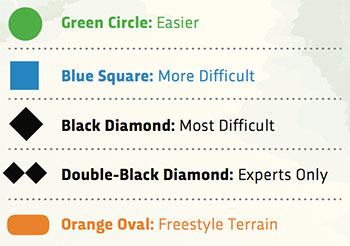
Powder & Deep Snow Safety Tips
The most important prevention step is to remain on groomed runs (see Groomed and Ungroomed Trails section), resisting the urge to ski or snowboard through the trees during deep powder conditions, no matter how inviting the untracked powder looks. Off-piste skiing/riding (defined as areas that may be off-trail and may or may not be within the ski area’s boundary) is extremely difficult and for experts only. Unmarked hazards and obstacles of all types, downed trees, stumps, rocks, boulders, and creeks are to be expected, and may be located anywhere throughout off-trail areas, and are dangerous. These areas are not regularly patrolled and are to be entered at your own risk. If you choose to ski or snowboard in the ungroomed, deep snow areas including gladed tree areas, remember:
1) Partner Up!
It is critical to ski or ride with a partner who remains in visual contact at all times. In many cases, some of the deaths which have occurred due to tree well or deep snow immersion incidents may have been avoided had:
- the person been with a partner
- the partner saw the person fall and
- the partner was close enough to assist digging the victim out in a timely manner.
It does NO GOOD for your safety if you are under the snow and your partner is waiting for you at the bottom of the lift. If you have any question about what a “timely manner” is to assist someone in a tree well or deep snow, hold your breath now as you are reading this and the amount of time until you need air is approximately how much time your partner has to help get you out of danger. Other factors such as creating an air pocket or the nature of how you fall into the well may extend this critical timeframe.
VISUAL CONTACT means stopping and watching your partner descend at all times, then proceeding downhill while he or she watches you at all times. IF YOU LOSE VISUAL SIGHT OF YOUR PARTNER, YOU COULD LOSE YOUR FRIEND.
2) Carry Backcountry gear and wear a helmet
Carry the same personal rescue gear as backcountry skiers or snowboarders:
- Transceiver
- Shovel
- Probe
- Whistle
3) If you are a skier, remove your pole straps
If you are a skier, remove your pole straps before heading down a powder slope. Trapped skiers have difficulty removing the pole straps, which can hamper efforts to escape or clear an air space to breathe.
What If I Go Down?
- If you are sliding toward a tree well or a deep snow bank, do everything you can to avoid going down: grab branches, hug the tree, or anything to stay above the surface.
- If you go down, resist the urge to struggle violently. The more you struggle, the more snow will fall into the well from the branches and area around the well and compact around you.
- Instead of panicking, try first to make a breathing space around your face. Then move your body carefully in a rocking manner to hollow out the snow and give you space and air.
Hopefully, your partner will have seen what happened and will come to your rescue within minutes. If not, experts advise staying calm while waiting for assistance. Survival chances are improved if you maintain your air space. Over time, heat generated by your body, combined with your rocking motions, will compact the snow, and you may be able to work your way out.
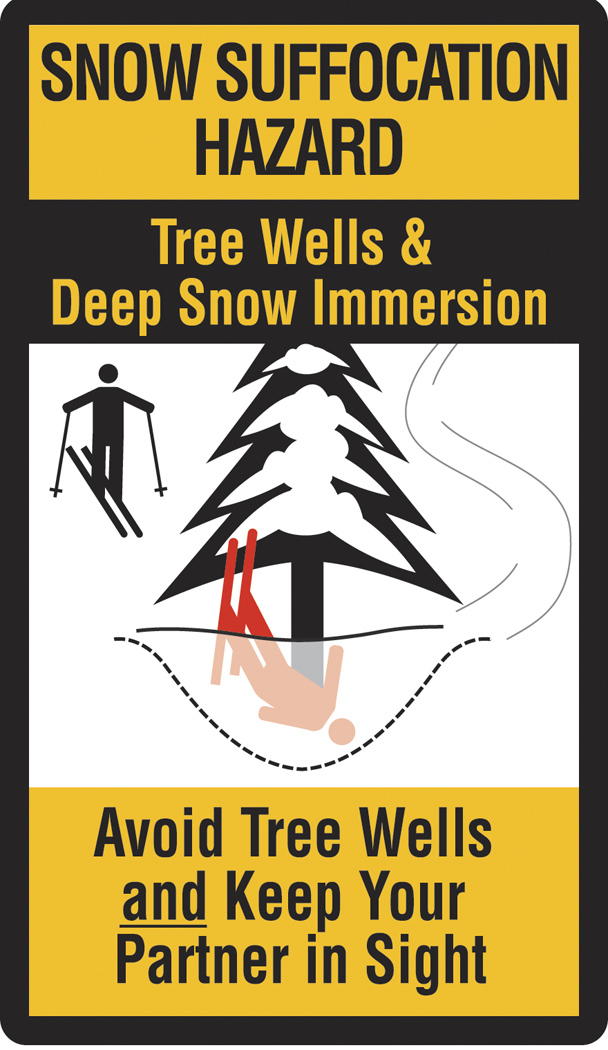
Avalanche Safety Tips
While snow safety and avalanche mitigation efforts help reduce the risk of avalanches, avalanches and snow slides may occur at ski areas, both inside and outside of the posted boundaries. Avalanches are an inherent risk of the sport due to the nature of snow and its application on steep, mountainous terrain.
Become educated on how to reduce the risk of injury or death from avalanches through your own actions and awareness.
- Always ski with a partner and keep them within your sight lines at all times
- Obey all signs and closures
- Carry avalanche equipment such as beacons or transceivers, reflectors, probes, and shovels when skiing or riding in areas where avalanches may occur
- Wear a helmet, or seriously consider it
Visit www.avalanche.org or contact Sierra-at-Tahoe Ski Patrol for further information on the risks and prevention of avalanche-related injuries or death.
* View avalanche conditions courtesy of Sierra Avalanche Center. Click HERE for more details.
Sierra Avalanche Dogs
Not only do the Sierra Avalanche Dogs put smiles on countless faces, they also save lives. Sierra Avalanche Dogs Inc. is a 501 C-3 non-profit that was initiated in the 2011/12 ski season. The purpose of the fund is to help with the maintenance and training of the Avalanche Rescue Dog Teams at Sierra-At-Tahoe. Our Dog Teams are trained to a high level of competence, in both dog and handler, increasing the potential for live recovery of humans in the event of an avalanche incident. Our program is structured on the Switzerland Standards for Avalanche Rescue Dog Training. The dogs also provide avalanche awareness through education at local schools and public relations.
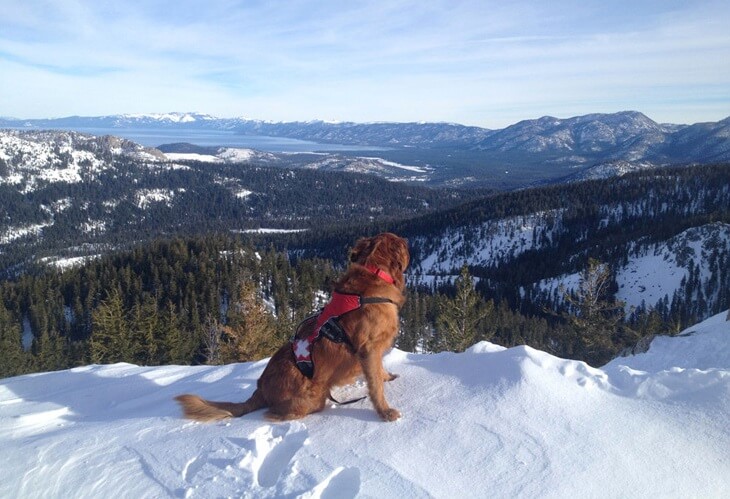
Uphill Access + Use Policy
The Uphill Access and Use Policy outlines permitted uphill access at Sierra-at-Tahoe Resort. Uphill access is the use of the resort by means of skinning, snowshoeing, hiking, and running. This policy governs all terrain within the Sierra-at-Tahoe permitted boundary in which the resort is actively engaged in operations. Sierra-at-Tahoe and the United States Forest Service (USFS) encourage the use of public lands. Users should be aware that the public lands comprising Sierra-at-Tahoe are under a special use permit by the USFS.
• All uphill users are required to have a Sierra-at-Tahoe Uphill Use Ticket or Season Pass product in their possession. Tickets and passes are available at the Season Pass office during the resort’s normal operating hours.
• Non-lift access at Sierra-at-Tahoe, such as uphill “skinning”, hiking, snowshoeing, may present high danger of personal injury to participants or others, and therefore may be limited or forbidden based on conditions, on-mountain activity and/or mountain policy.
• Uphill access is not allowed while pre-season mountain preparations are in progress, during low snow conditions when the resort or portions of it are not open to the public; during avalanche mitigation work, and/or during other resort operational work impacting public areas.
• All uphill users are required to read and sign an Uphill Access release of liability prior to pass issuance or uphill access.
•Users must abide by the rules and regulations established by Sierra-at-Tahoe and USFS when accessing Sierra-at-Tahoe for uphill access.
•All uphill users must adhere to and obey all posted information and be aware of trail closures and other operational considerations. Snowmobiles, snowcats, winch cat cables, snowmaking hoses, and other equipment may be encountered at any time.
•All users accessing resort trails or permitted areas at any time, with or without a ticket/pass, assume ALL RISKS OF INJURY OR DEATH associated with uphill access.
•At all times it is prohibited to approach within 100 feet of grooming machines, snowmobiles, winch cats, winch cables (stationary or moving), or snowmaking equipment including but not limited to fan guns, high pressure water lines, and high voltage electrical cables.
•Headlamps are required and must be turned on during dark or twilight hours. Reflective clothing is recommended.
•If the resort staff feels that users are presenting a hazard or are impeding operations the user will be asked to leave the resort.
•The use of terrain parks and terrain park features is prohibited by uphill users.
•Medical response, first aid, and transport off the mountain is not available after the resort closes for normal operations. Users must understand that they are responsible for their own rescue. Call 911 in the event of an emergency and be aware rescue may take time to arrive.
•Dogs are not permitted.
•Users must understand and accept that resort personnel may be performing maintenance on chairlifts and that chairlifts may be running. At no time should uphill users board a chairlift, running or not.
•Use of Terrain Park features is prohibited outside of normal operating hours.
•Obey all pertinent signage.
•Position yourself so that you are visible from above.
•Uphill access may be closed at any time during periods of inclement weather or while avalanche mitigation operations are underway.
•Snowmaking hoses –Warning, high pressure. Do not ski over snowmaking hoses.
•Electrical cords – Danger. Do not walk or ski over electrical cords. They are 480 volts or greater and are live even when snow gun is not operating. In general, avoid traveling between snowmaking machinery and the tree line.
•Stay away from hydrants. While in use they will not have pads on them.
•Snowmobiles – Stay away from snowmobiles and if you see one make yourself visible.
•Snow Cat Grooming Machines – Give Snow Cats a wide berth and make yourself visible to operators. Do not assume they can see you. Do not ski down directly behind grooming machinery in the fresh corduroy.
•Winch Cat Operations – Dangerous cable. Winch Snow Cats attach to cables to groom on steep slopes. Such work will involve cables stretched tight across the terrain on the slope and above the slope. This is very dangerous. Under no circumstance may anyone access any area within the resort where winch cat operations are taking place. Skiing into them can result in serious injury or death. Winch cables are known to move in any direction and can jump multiple feet into the air when in use. IF YOU SEE A FLASHING BEACON DO NOT TRAVEL BEYOND IT OR GO NEAR IT.
•Other hazard areas, operations or conditions may exist on the mountain including but not limited to the following risks: collisions with other skiers or riders, natural and manmade objects, trees, rocks, fences, lift towers, snowmaking equipment, over the snow vehicles such as snowmobiles or grooming equipment, unfinished grooming activity, loss of control, variations in terrain and snow conditions, bare spots, bumps, moguls, ice, stumps, forest growth and debris, erosion control devices, terrain park features, walking on the resort property and parking lots.
•Sierra at Tahoe is a mountain environment that requires your alertness, common sense and caution. Read and obey all signs. Be sure your physical condition permits you to hike, ski, snowboard, skin or otherwise use resort facilities. Be aware that high elevation can accentuate existing health problems and concerns.
•Uphill access is available before or after normal daily operations only.
•Uphill access is available until 8:00 a.m. and after 5:00 p.m.
•Uphill access is prohibited during normal resort operating hours.
•Uphill access is only allowed on designated trails.
•Freestyle Terrain Park usage is not allowed.
•Pre-season access is not allowed due to snowmaking and grooming operations.
•Post-season access is not allowed due to mountain operations such as road plowing
Only the below runs/routes are available for uphill access.You must come down the same way you go up.
From the base area:
- Sugar n Spice from the base of Grandview Express to the top of Grandview Express.
- Broadway beginning at the base of Easy Rider Express to Lower Sleighride to Echo
- Broadway beginning at the base of Easy Rider Express to Lower Sleighride, Escape, to the top of Westbowl Express.
From the base of Westbowl
- Marmot beginning at the base of Westbowl Express.
All trails other than those specified above areCLOSEDto uphill traffic.
When uphill access is allowed, users must remain near the center of the trails and use thesame route to returnto the base area used to travel uphill.
People travelling uphill must not impede or obstruct ski area operations at any time.
Proper ski retention devices are required.
- Snowmobiles are prohibited at all times on Sierra-at-Tahoe resort property.
- Be advised, snowmobile operations may be underway by resort personnel. Stay away from all snowmobile traffic.
Use of sliding devices, including but not limited to, sleds, tower pads, plastic sheets, or plastic discs and the like are strictly prohibited.
- There is no charge for the pass.
- All persons are required to sign the Uphill Access Policy Release of Liability before accessing the mountain.
- Persons travelling uphill without having signed the access and use policy release of liability will be asked to leave the resort.
- Signing in person is available in advance at the Sierra at Tahoe pass office during normal business hours.
Before You Earn Your Turns
Before heading up to Sierra to earn your turns, you must sign our Uphill Access Waiver. We recommend you always know before you go, check our current conditions page and maintain Backcountry safety protocol.
DRONE / UAV POLICY
Photography is allowed across the resort and at all events. Please note, however, that drones and all other unmanned remote-controlled aircraft are not permitted to be flown anywhere on resort property for photography, video or any other use. This restriction includes aircraft that would be launched off-site but subsequently flown above resort property.
Violation of this policy may result in the suspension of your skiing / riding privileges at Sierra-at-Tahoe.
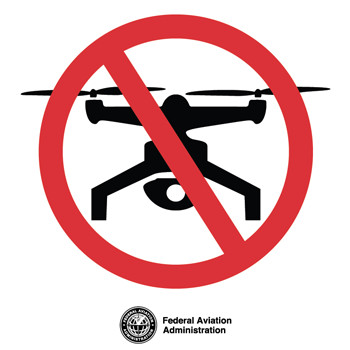
FAQ on Proposition 64 and Question 2:
What you need to know about the legalization of marijuana use in California and Nevada when you visit ski resorts in both states.
What did these initiatives do?
Both initiatives make it lawful for individuals 21 years of age or older to consume marijuana in a private home or authorized business location.
Does the passing of these initiatives mean you can possess or consume marijuana at California and Nevada ski resorts?
No, for several reasons.
- Most ski resorts in California and Nevada are located on U.S. Forest Service land. The federal government regulates drugs through the Controlled Substances Act (21 U.S.C. § 811), which prohibits the possession and use of marijuana on federal land. Therefore, possession or use of marijuana at ski resorts on federal land (or any federal land) is against the law. Violators are subject to a minimum $1,000 fine and/or up to one year in prison (21 U.S.C. § 844). Repeat violators face stiffer penalties.
- Despite the new laws, it remains illegal to consume marijuana in all public places in California and Nevada. Every ski resort in both states is a “public place,” and therefore consuming marijuana is not permitted, even in currently designated smoking areas. This includes every location at a ski resort, including all facilities, trails, off piste areas, chairlifts, gondolas, lift lines, and parking lots.
- Marijuana impairs your senses. Skiing, snowboarding, and other recreational activities at ski resorts are athletic activities that require dexterity, skill, and awareness. Participating in these activities while impaired is neither safe for you nor those enjoying the activities with you.
Do all ski resorts have specific policies about using marijuana?
Yes. Please check each resort’s website or ask resort personnel if you have any questions. In short, do not possess or use marijuana illegally at any California or Nevada ski resorts or you will be subject to ejection, arrest, and/or prosecution.
[youtube single - Inside Ski Patrol]
Inside Look at Sierra's Ski Patrol
Celebrating the team that keeps us safe on the mountain all season. Thank you Sierra Ski Patrol.
Your safety is our top priority. Safety is a shared responsibility between our guests and us. We take our responsibility seriously, and by following these tips, we know you will too.
Sierra offers Lake Tahoe's best lift ticket deals. Whether you're planning to ski/ride for just one day, a weekend, an extended weekend or you’re trying out a new resort we've got affordable prices and extra savings if you buy online in advance!
Your Season Pass comes loaded with perks like Unlimited BFF tickets, bring a Friend for Free on select Fridays + 20% off around the mountain on things like rentals, dining + lessons. PLUS, much much more!